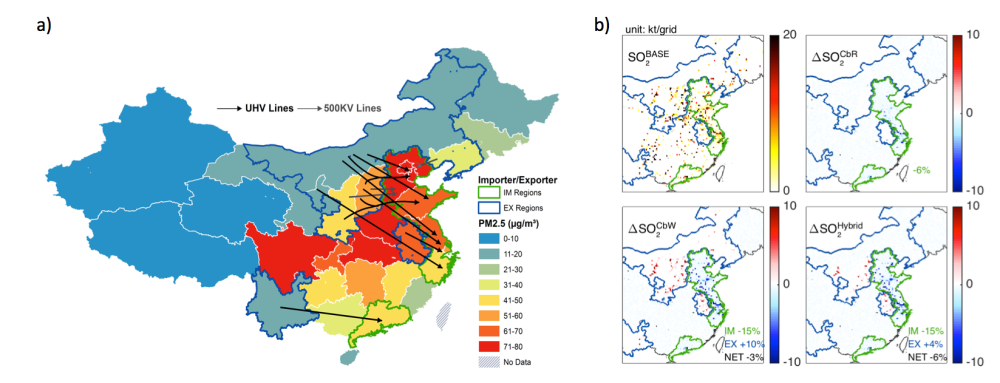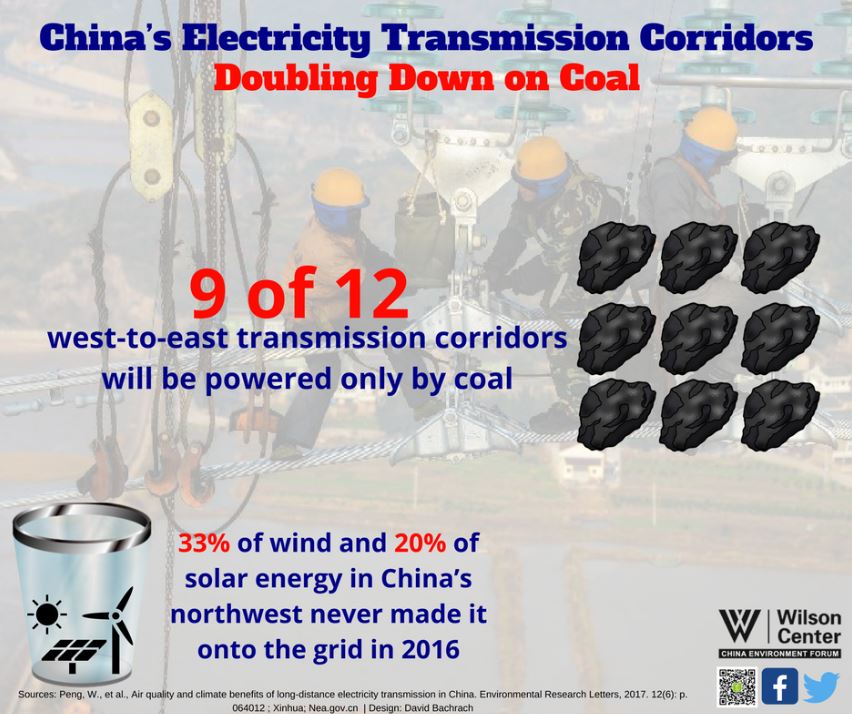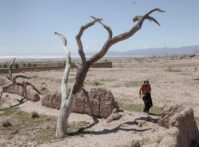-
China’s Silver Bullet: Can the Transmission Grid Solve China’s Problems?
October 20, 2017 By Wei Peng
With air pollution causing more than one million deaths in 2015 and reducing the lifespan of citizens in northern China by three years, clean energy has become a top priority for China’s leaders. China tops the world in wind and solar power installations and the government plans to invest more than $360 billion through 2020 on renewable energy. But the green energy transition needs more than renewable power generation: Long-distance electricity transmission could play a key role in cleaning up China’s brown skies. Our recent study estimated that transmitting a hybrid of renewable and coal power through 12 new high-voltage transmission lines could prevent 16,000 deaths from air pollution exposure, and avoid 340 million tons of CO2 emissions in China.
High Voltage Transmission: Reaching Demand and Reducing Wasted Energy
Most of China’s energy resources (coal, wind, solar and hydropower) are located in the vastness of western China. These resources are delivered to the provinces on China’s eastern coast, which consume 30 percent of the country’s energy. Currently, China is constructing 12 electricity transmission corridors for air pollution control, making it the first nation in the world to design transmission to improve air quality. These corridors will minimize coal-fired power generation and associated air pollution in three eastern metropolitan regions– Beijing-Tianjin-Hebei, the Yangtze River Delta regions, and the Pearl River Delta regions–by importing electricity produced in other provinces, including major coal producing provinces like Shanxi, as well as provinces abundant in hydro and wind resources, such as Yunnan and Inner Mongolia.
These transmission lines can help abate pollution and reduce carbon emissions by making it easier to integrate renewable sources into the electric grid. Wind and solar resources are abundant in the remote areas of northern and western China. The demand for electricity, however, is much higher in the eastern part of the country. In 2016, 33 percent and 20 percent of the wind and solar power generated in the northwest regions were curtailed, or unused, partly due to lack of transmission to reach the demand. The total amount of wasted renewable power was enough to power Beijing for an entire year—but only if it could have reached the city.
High-voltage electricity transmission lines are one possible solution. By increasing the voltage to a very high level, large quantities of electricity can be transmitted over long distances with little loss of power. China now leads the world in developing and deploying ultra-high-voltage (UHV) technology, which are direct current transmission lines at voltage of ±800kV (UHV-DC) and alternating current lines at 1000kV (UHV-AC). At present, 30,000 kilometers of UHV-DC lines are under construction or in operation in China. In comparison, most transmission lines in the United States operate at lower voltages (from 230kV to 500kV).
Twelve Electricity Transmission Corridors for Air Pollution Control

Renewable-By-Wire or Coal-By-Wire?
Building new transmission capacity doesn’t necessarily mean that more renewable electricity will be integrated into the grid. Of the 12 transmission corridors for air pollution control, only three are planning to integrate renewables: Two in northern China will transmit a hybrid of wind and coal power, and one in the south will deliver hydroelectricity. The rest will rely on coal power, which contributes little to renewable integration or carbon mitigation.
Such a grid design may clean up the air in eastern pollution centers. But expanding coal-fired power generation in the exporting provinces is likely to degrade air quality in western regions, escalating inequality and increasing the environmental and ecological stress between power importing and exporting provinces. It also leads to a potential tradeoff between air pollution and carbon mitigation objectives: resolving eastern air pollution at the expense of continued reliance on coal-fired power generation in remote regions.
Transmission lines often have a long lifetime, lasting a few decades. When building new power lines, we must consider the long-term air pollution and carbon footprint over the line’s lifetime. UHV-DC transmission lines are a targeted way to transfer energy: they take electricity from the exporting region, increase the voltage to transmit it over long distances, and then lower the voltage at the destination. If the exporting region is rich in coal resources, like Shanxi, this line will mainly transmit coal power throughout its lifetime, unless new transmission investments are made to connect other areas with renewable resources. These lines may help clean up near-term smoggy air in the recipient regions, but they are unlikely to reduce carbon emissions. In comparison, other exporting provinces, like Inner Mongolia and Liaoning, are abundant in both coal and renewable resources. Even if the current plan is to predominantly transmit coal-fired power, these lines could accommodate some renewable sources in the future.
Coordinated Transmission of Coal and Renewables
Powering long-distance transmission lines with renewable electricity only can be technically challenging and economically unfavorable. Wind and solar generation are intermittent and variable; the wind doesn’t blow all the time and the sun doesn’t shine all day. Hydroelectric resources also vary substantially across seasons. Daily or seasonal variations in the currents may challenge the reliability of power lines. More importantly, given variable renewable output, the transmission lines cannot operate at full capacity all the time. A low utilization rate means less electricity is transmitted and sold to utility companies, producing less revenue for grid investors seeking to recoup their investment costs.
China is experimenting with one promising strategy: integrating variable energy sources like wind and solar with coal-fired power and then transmitting both renewable and non-renewable electricity. The UHV-DC line from Hami in the Xinjiang Autonomous Region to Zhengzhou in Henan Province delivers a mix of wind and coal power from northwestern to central China. Although coal-fired power generation may not be flexible enough to make up for the variability of wind power at the source region, the “hybrid-by-wire” strategy allows the lines to have a high utilization rate, and provides the flexibility to increase the share of renewable transmission in the future.
Coordinating transmission lines with renewable energy deployment is critical to maximizing the air quality and climate benefits from energy-by-wire strategies. Using long-distance, high-voltage electricity transmission to deliver electricity from renewable resources to highly populated and polluted regions could increase the use of green energy, reduce carbon emissions, and maximize air quality and health benefits.
Wei Peng is a Giorgio Ruffolo Postdoctoral Research Fellow in sustainability science at the Belfer Center for Science and International affairs at the J.F. Kennedy School of Government, Harvard University.
Sources: Berkeley Energy and Resources Collaborative, The Economist, Forbes, The Guardian, Lantau Group, Lawrence Berkeley National Lab, National Energy Administration, New York Times, Paulson Institute, South China Morning Post, State Grid Corporation of China, University of California Berkeley, University of Chicago, Xinhua News
Photo Credit: Xu Li, China Business Times, August 2013.
 A Publication of the Stimson Center.
A Publication of the Stimson Center.








